Diamonds to Rice
Air Date: Week of February 1, 2008
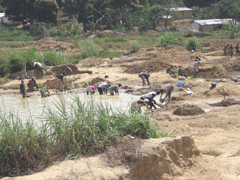
Diamond mining at the Tankoro site in Sierra Leone. (Photo: FESS)
A non-governmental organization teams up with Sierra Leonians to rebuild their war torn country - planting rice fields where once lay the raw earth remnants of conflict diamond mining. Host Bruce Gellerman speaks with Darci Glass-Royale, executive director of FESS, the Foundation for Environmental Security and Sustainability, and Daniel Gbondo, a Sierra Leonian who works for FESS in his home country.
Transcript
GELLERMAN: It’s Living on Earth, I’m Bruce Gellerman. One of the poorest nations on the planet is also one of the richest in diamonds. And for that - Sierra Leone has paid a price in blood.
In the 1990’s the country’s diamond mines fueled a decade of terror, a vicious civil war fought for control of the nation’s mineral wealth. It’s a war many of us know about, but only because of a Hollywood film - “Blood Diamond.”
Seventy-five thousand people were killed in Sierra Leone, tens of thousands maimed and nearly a third of the population driven from their homes. Now the mud-pit diamond mines, which caused so much suffering, are being transformed into fields of rice. The effort is being led by the Foundation for Environmental Security and Sustainability, or FESS. It gets most of its funding from the U.S. Agency for International Development.
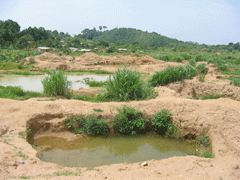
Damaged land to be reclaimed at the Tankoro site.(Photo: FESS)
GLASS-ROYAL: Thank you. Thank you for inquiring about the work that we’re doing in Sierra Leone.
GELLERMAN: Ms. Glass-Royal is in New York City now, traveling with Daniel Gbondo who is the head field organizer for FESS in Sierra Leone and a Sierra Leonean himself. Mr. Gbondo, welcome to Living on Earth.
GBONDO: Thank you very much and thank you for hosting us.
GELLERMAN: Let me ask you Ms. Glass-Royal first: how do you turn a diamond mine into a rice field?
GLASS-ROYAL: It’s a bit of a challenge. After many years of digging the area is left incredibly pitted. It looks like the surface of the moon, if the moon had villages. And what we have done is gone through an extensive process working with local communities to hire workers so that we can begin filing in the soil and take areas of land that are not productive and return them to agriculture.
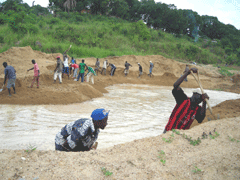
Reclaiming land at the Tankoro site. (Photo: FESS)
But it was our goal to say that in an area that, because of the rich volcanic soil, can be so agriculturally productive, an area that used to be the breadbasket of West Africa, that there was just no way that the country could continue to grow economically and feed its people without returning to agriculture.

Diamond mining at the Tankoro site in Sierra Leone.(Photo: FESS)
GBONDO: The township was completely destroyed. I mean, systematic burning of houses - by street by street, house by house. And some houses were bulldozed and mined and streets were mined for diamonds. Diamonds actually fueled the conflict in Sierra Leone at the time and there was just indiscriminate mining all over the place - destroying the streets, destroying the environment.
GELLERMAN: And I understand that you actually lost some people very close to you during the civil war.
GBONDO: Oh, yeah. My elder brother worked in the diamond mines. He was killed during the civil war. My father was killed during the civil war.
GELLERMAN: How many acres have you been able to convert?
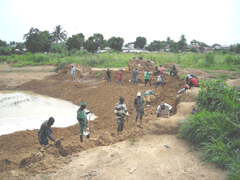
Many of the workers reclaiming the pits fought in the civil war, or are former diamond miners.(Photo: FESS)
GELLERMAN: Daniel, can you tell me a story about someone who’s been influenced by your work? Maybe someone who you know who’s been helped to recover from the civil war because of this project?
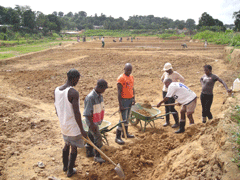
Creating swamp rice field at the Tankoro site.(Photo: FESS)
GELLERMAN: Mr. Gbondo, it seems to me you’re in a unique position. I mean here you are working for this NGO, this nongovernmental organization, and you bring together the two worlds. You’re helping your country in the process and you can join it with kind of this Western association.
GBONDO: For me, I see myself lucky in a way to be part of this. Talking to my American friends, you talk to them about Sierra Leone and all they know is the “Blood Diamond” movie—‘oh, these guys are just good at killing people.’ But this project is telling the other side of the story. That there are efforts out there to address the problems associated with diamond mining—environmental problems, social problems, health risk in Sierra Leone. And I see this as an opportunity that I am part of it: one, to help transform my society, and two, to help spread a message that there is another side to diamond mining in Sierra Leone.
GELLERMAN: It seems to me, Ms. Glass-Royal, that this project isn’t just about land use.
GLASS-ROYAL: This project is about transforming communities and bringing stability and growth to a fragile but very critical part of the world.
GELLERMAN: Darci Glass-Royal is the co-founder and executive director of the Foundation for Environmental Security and Sustainability. Daniel Gbondo is the head field organizer for FESS in Sierra Leone. Well I want to thank you both very much for joining us.
GLASS-ROYAL: And thank you for hosting us.
GBONDO: Thank you very much for having us here.
Links
FESS: Foundation for Environmental Security and Sustainability
Living on Earth wants to hear from you!
Living on Earth
62 Calef Highway, Suite 212
Lee, NH 03861
Telephone: 617-287-4121
E-mail: comments@loe.org
Newsletter [Click here]
Donate to Living on Earth!
Living on Earth is an independent media program and relies entirely on contributions from listeners and institutions supporting public service. Please donate now to preserve an independent environmental voice.
NewsletterLiving on Earth offers a weekly delivery of the show's rundown to your mailbox. Sign up for our newsletter today!
 Sailors For The Sea: Be the change you want to sea.
Sailors For The Sea: Be the change you want to sea.
 The Grantham Foundation for the Protection of the Environment: Committed to protecting and improving the health of the global environment.
The Grantham Foundation for the Protection of the Environment: Committed to protecting and improving the health of the global environment.
 Contribute to Living on Earth and receive, as our gift to you, an archival print of one of Mark Seth Lender's extraordinary wildlife photographs. Follow the link to see Mark's current collection of photographs.
Contribute to Living on Earth and receive, as our gift to you, an archival print of one of Mark Seth Lender's extraordinary wildlife photographs. Follow the link to see Mark's current collection of photographs.
 Buy a signed copy of Mark Seth Lender's book Smeagull the Seagull & support Living on Earth
Buy a signed copy of Mark Seth Lender's book Smeagull the Seagull & support Living on Earth

